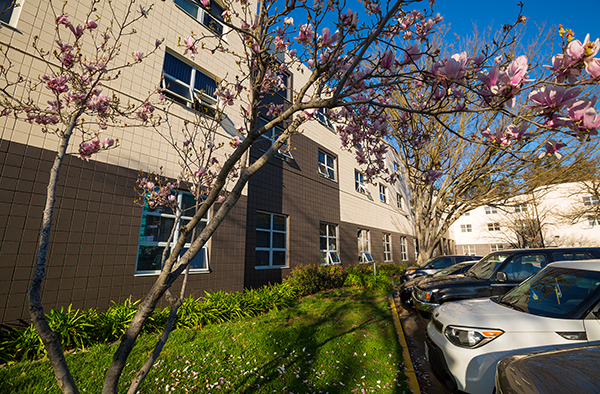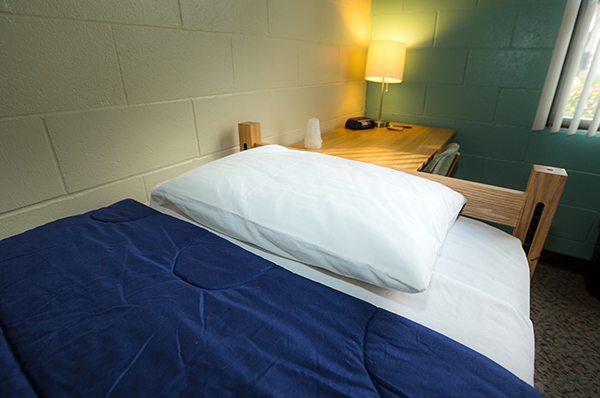 Desmond Hall on campus will be welcoming students in the new Student Emergency Housing Program. (Sacramento State/Rob Neep)
Desmond Hall on campus will be welcoming students in the new Student Emergency Housing Program. (Sacramento State/Rob Neep)Sacramento State has stepped up to shelter students who suddenly find themselves homeless.
“We have students who are sleeping in their car, on a friend’s couch, on church steps, in tents, or in local shelters, because they can’t pay their rent,” says University case manager Danielle Muñoz, whose role is to aid students in crisis.
The new Student Emergency Housing Program will allow for one male and one female student at a time to live in a residence hall for up to 30 days, meals included. Eventually, the program will expand to accommodate two additional students.
The University’s efforts to address student financial hardships also include a program to help those who experience food insecurity, and the University has established a new campus task force on housing and food insecurity.
“The students aren’t doing anything wrong. It’s just that they’re living in a city that’s hard to afford,” Muñoz says. “When it starts to impact their college plans is when we feel responsibility as a university to help them manage. Some students talk about, ‘It’s either work full time just to survive and live here, or drop out of school.’ ”
The high cost of living in Sacramento, where apartment rents average $1,200 monthly, has left some students out into the cold.
Approximately 45 percent of Sacramento State’s 30,000 students are low-income and Pell Grant-eligible. A 2015 survey of administrators, faculty, and staff at the 23 California State University (CSU) campuses revealed that an estimated 8.7 percent of students are displaced, and 21 percent are identified as food-insecure. However, when students themselves were asked, 12 percent said they’re homeless, and 24 percent admitted to not having enough money for food.
 (Sacramento State/Rob Neep)
(Sacramento State/Rob Neep)“We want to support the students,” Muñoz says. “We value the idea of like-equity and equal access to education. Students shouldn’t have to think about dropping out of school because they can’t afford their rent.”
The Student Emergency Housing Program is a collaboration of Student Affairs, Housing and Residential Life, Associated Students Inc. (ASI), and University Enterprises Inc. ASI, the official governing body of Sac State students, has funding from Wells Fargo Bank and other partners to pay for two meals a day at the campus Dining Commons.
“As the California State University in the state’s capital, we take pride in leading the charge when it comes to serving students in crisis,” says ASI President Patrick Dorsey.
ASI launched its on-campus food pantry at the start of the 2015-16 academic year after a 2013 study revealed that 60 percent of responding students said they sometimes needed help supplementing their food source.
Students may visit the food pantry in Yosemite Hall once a week and, with their valid Sac State OneCard, can spend points on toiletries and nonperishable food items. The pantry depends on donations from the Sac State community and local businesses. It has served 669 students since the beginning of the Fall 2016 semester.
And, in partnership with the Central Downtown Food Basket, ASI also runs a pop-up pantry that provides fresh fruit and produce to students.
In addition, Muñoz connects displaced students with community agencies that find them long-term housing. She also helps students apply to Sacramento State’s Student Emergency Fund, which provides immediate monetary assistance. And she is hoping to establish a new program called Host a Hornet, which would match Sacramento State alumni with current students experiencing food insecurity.
“The idea is that the student has a warm, home-cooked meal at least once a month, hosted by alumni,” she says. “The other idea is to reduce the stigma of food insecurity. We want them to have a connection with each other, feel a part of the Hornet Family, and enjoy each other’s company.” – Dixie Reid
In the media: "Sacramento State offers emergency housing to homeless students," KCRA 3
